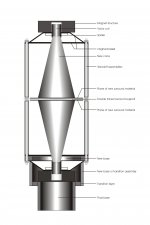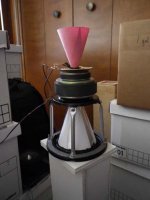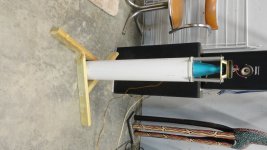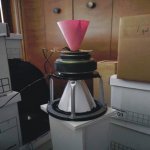Aha! Discovered the 'cranky source' issue, which actually was a driver issue. The hair fine wires to the vc, which as we've all noted, run on the cone and attach to larger and stiffer jumper wires which lead to the exterior connectors. In the process of trimming the cones, I created a 'hinge point' where the fine wire goes from cone to the vc tube, then onto the vc winding itself. Vibrated enough, the wire gives up. You can 'poke' it back into contact temporarily, but once broke, poof.
Todays' lesson: Leave more material about those wires, and transfer the movement back to the jumpers, which are typically braided and made to handle the forces involved......
Fortunately, I've got more of that size/style of speaker at hand, so the setback isn't catastrophic. And I'm getting good at repairing my own speakers. *L*
Todays' lesson: Leave more material about those wires, and transfer the movement back to the jumpers, which are typically braided and made to handle the forces involved......
Fortunately, I've got more of that size/style of speaker at hand, so the setback isn't catastrophic. And I'm getting good at repairing my own speakers. *L*
(This is a copy of a post I made 'elsewhere'...if you've any interest at all in what I'm doing, you may be 'there' already. If not...)
Had a thought to contact Michael Marks, the gentleman that repairs the Infinity/Walsh tweeters via his site on eBay. He was gracious to give me his thoughts on what I was up to and where my approach could be improved.
Basically:
-Make the cone less 'steep'; mine are at 75 degrees, go to 60.
-Cone material is less important; what is important is to have a material that can create the initial 'impulse' from the vc without 'ringing' due to the cones' vibration modes.
-Damping at the edge to absorb any 'back wave' is important; I interpret this as helping to eliminate the vibration modes that would enhance 'cone ringing'.
-Use as large a vc as possible to allow as great a range as possible.
Now, the above is what I understood from our chat; I won't claim that it's verbatim, just my interpretation of his comments. Very interesting, insightful, and gives me some interesting paths to follow as I continue.
Cone material selection becomes either simpler or more complex, depending upon how big one wants to go with the size. Mike suggested I try a metallic poster board (I'd assume a thin stock thickness) for smaller cones. Whereas HHR/Ohm utilize titanium+aluminum+paper cones in a 'stepped'/'stacked' fashion, I'm nowhere near the size and sophistication needed to pull those off. German Phys units look like they're fashioned from a single material from what I see...
He thought my idea of making a Walshish tweeter would only yield something that would radiate in the range of 16K. Since we agreed that neither of us could hear that, it'd be kinda pointless. An interesting exercise, IMHO, and I could certainly get the attention of my 2 dogs. They'd likely be more interested in their kibble...
As for vc size, if one wants to go for a 'single driver' unit, GO BIG. A 1" vc is essentially the minimum; 2", 3", as big as you can go. The limiter there will be the size of the material you'll use to create the cone attached. The bigger the cone, the larger the initial sheet of material you'd need to create it. The bigger the cone, the deeper you can go bass-wize. Then, of course, there's the surround material to consider, which the bulk of whatever it may be will become trash can liner...
I think I'll stay with my initial approach re size: units that can yield high to mids, using a sub or separate woofers for the 'bottom'. At this time I'll concentrate on the cone/surround conundrum, stay with 1" vcs' since I've got a handful of them, play about with baffle size (I got the 'slide whistle test unit' roughed out, complete with a 'guesstimate' port that can be open/close as desired), and goof around with all that for awhile....
Yeah...not too much to do...*LOL* Can you or anyone give me an analysis of the difference between a hobby and an obsession, and where the division betwixt gets crossed? I think I'm starting to edge over towards it...
Had a thought to contact Michael Marks, the gentleman that repairs the Infinity/Walsh tweeters via his site on eBay. He was gracious to give me his thoughts on what I was up to and where my approach could be improved.
Basically:
-Make the cone less 'steep'; mine are at 75 degrees, go to 60.
-Cone material is less important; what is important is to have a material that can create the initial 'impulse' from the vc without 'ringing' due to the cones' vibration modes.
-Damping at the edge to absorb any 'back wave' is important; I interpret this as helping to eliminate the vibration modes that would enhance 'cone ringing'.
-Use as large a vc as possible to allow as great a range as possible.
Now, the above is what I understood from our chat; I won't claim that it's verbatim, just my interpretation of his comments. Very interesting, insightful, and gives me some interesting paths to follow as I continue.
Cone material selection becomes either simpler or more complex, depending upon how big one wants to go with the size. Mike suggested I try a metallic poster board (I'd assume a thin stock thickness) for smaller cones. Whereas HHR/Ohm utilize titanium+aluminum+paper cones in a 'stepped'/'stacked' fashion, I'm nowhere near the size and sophistication needed to pull those off. German Phys units look like they're fashioned from a single material from what I see...
He thought my idea of making a Walshish tweeter would only yield something that would radiate in the range of 16K. Since we agreed that neither of us could hear that, it'd be kinda pointless. An interesting exercise, IMHO, and I could certainly get the attention of my 2 dogs. They'd likely be more interested in their kibble...
As for vc size, if one wants to go for a 'single driver' unit, GO BIG. A 1" vc is essentially the minimum; 2", 3", as big as you can go. The limiter there will be the size of the material you'll use to create the cone attached. The bigger the cone, the larger the initial sheet of material you'd need to create it. The bigger the cone, the deeper you can go bass-wize. Then, of course, there's the surround material to consider, which the bulk of whatever it may be will become trash can liner...
I think I'll stay with my initial approach re size: units that can yield high to mids, using a sub or separate woofers for the 'bottom'. At this time I'll concentrate on the cone/surround conundrum, stay with 1" vcs' since I've got a handful of them, play about with baffle size (I got the 'slide whistle test unit' roughed out, complete with a 'guesstimate' port that can be open/close as desired), and goof around with all that for awhile....
Yeah...not too much to do...*LOL* Can you or anyone give me an analysis of the difference between a hobby and an obsession, and where the division betwixt gets crossed? I think I'm starting to edge over towards it...
the best Ohm Walsh F and A information I've found
Hey JR, maybe you have seen them but there are 2 documents that explain more than I could find in 100 hours of searching forums.
The patent that Lincoln Walsh appears to have written himself.
Patent US3424873 - Coherent-sound loudspeaker - Google Patents
you can download the PDF and print it off. I read through it a couple of times and found there are only about a dozen paragraphs that I found important, I still don't understand them all but maybe one day, I marked them so it was easy to jump to when I had a free minute and re-read them often.
and another PDF go here
HHR Exotic Speakers - History
and look for the link that says
[SIZE=-1]>> Read more about the original Ohm F and A loudspeakers..
(I did not want to link to it directly)
[/SIZE] I hope that helps some.
.
Hey JR, maybe you have seen them but there are 2 documents that explain more than I could find in 100 hours of searching forums.
The patent that Lincoln Walsh appears to have written himself.
Patent US3424873 - Coherent-sound loudspeaker - Google Patents
you can download the PDF and print it off. I read through it a couple of times and found there are only about a dozen paragraphs that I found important, I still don't understand them all but maybe one day, I marked them so it was easy to jump to when I had a free minute and re-read them often.
and another PDF go here
HHR Exotic Speakers - History
and look for the link that says
[SIZE=-1]>> Read more about the original Ohm F and A loudspeakers..
(I did not want to link to it directly)
[/SIZE] I hope that helps some.
.
Oh, I wish you would have asked....
Thanks for your time, but (hopefully) without intending to ruin your day, I already have a printout of the patent, including the drawings that were included. I noticed that some of the illustrations mention within the patent aren't posted, but I think I'll be able to infer what is being discussed...fingers crossed, of course...
I noticed that some of the illustrations mention within the patent aren't posted, but I think I'll be able to infer what is being discussed...fingers crossed, of course...
Yeah, the patent material gets 'dense', but having gone through the start of the process to get a patent eons ago, there's a need to be thorough about 'what it is' vs. 'not giving it all away'. In addition, there's the real possibility that someone can modify a dinky detail Just Enough to claim that your infringement claim is invalid and you can GFY. No guarantee you'll ever make a dime, either. I finally blew it off before I sank major cash into it...
The sad part is, Linc. W. probably didn't make much or what he deserved for all his work and effort...much like you at this point, either. *cringe*
I've also seen the HHR stuff, too.... To paraphrase F. Zappa in one of his earlier 'works', "I've stared at this *expletive deleted* box until my head began to hurt..." chasing down Walsh words. There are certain things I've read and been advised about that I'm going to 'ignore or circumvent' due to wanting to keep my 'investment' inexpensive $-wise. Inversely (or perversely, as it may be *L*), I'm happy to 'throw time @ it', because I've got the inclination to sharpen my fabrication skill set and muck around with just to see what happens....
I'm serious about what I'm doing, but not so serious that I don't expect to screw up. I fully expect to do the latter. History is replete with that scenario; unfortunately, some of the more important lessons don't get 'learned gud'. I'm sure you'll agree...
Me? I'm going to be more than happy to FIU and let y'all know I did. And what I did about it, and/or wait for y'all to laugh and chide me for it. And we all move forward....*G*
BTB, I just took 42 pics last night of part of the process I use to 'prep' and assemble one of 'my little mutants'. Next will be to annotate them and see what would be a reasonable way to post them for those willing to follow my descent into psuedo-Walsh perdition...
...so, stay tuned and maybe I'll 'make up' to you some of the time you burnt... And I really do appreciate the fact that you did.
And I really do appreciate the fact that you did.
Thanks for your time, but (hopefully) without intending to ruin your day, I already have a printout of the patent, including the drawings that were included.
Yeah, the patent material gets 'dense', but having gone through the start of the process to get a patent eons ago, there's a need to be thorough about 'what it is' vs. 'not giving it all away'. In addition, there's the real possibility that someone can modify a dinky detail Just Enough to claim that your infringement claim is invalid and you can GFY. No guarantee you'll ever make a dime, either. I finally blew it off before I sank major cash into it...
The sad part is, Linc. W. probably didn't make much or what he deserved for all his work and effort...much like you at this point, either. *cringe*
I've also seen the HHR stuff, too.... To paraphrase F. Zappa in one of his earlier 'works', "I've stared at this *expletive deleted* box until my head began to hurt..." chasing down Walsh words. There are certain things I've read and been advised about that I'm going to 'ignore or circumvent' due to wanting to keep my 'investment' inexpensive $-wise. Inversely (or perversely, as it may be *L*), I'm happy to 'throw time @ it', because I've got the inclination to sharpen my fabrication skill set and muck around with just to see what happens....
I'm serious about what I'm doing, but not so serious that I don't expect to screw up. I fully expect to do the latter. History is replete with that scenario; unfortunately, some of the more important lessons don't get 'learned gud'. I'm sure you'll agree...
Me? I'm going to be more than happy to FIU and let y'all know I did. And what I did about it, and/or wait for y'all to laugh and chide me for it. And we all move forward....*G*
BTB, I just took 42 pics last night of part of the process I use to 'prep' and assemble one of 'my little mutants'. Next will be to annotate them and see what would be a reasonable way to post them for those willing to follow my descent into psuedo-Walsh perdition...
...so, stay tuned and maybe I'll 'make up' to you some of the time you burnt...

*L* Me, either. Since I want it to be thorough and really 'follow the yellow brick road' simple, each pic will have some instruction as to what/why/how. If anyone wants to try, I'd like them to be successful; even if the end result doesn't hold a candle to a commercial product. There's that inherent value of creating something that Does Work, even if it won't make one want to toss the Martin Logans' into the garage...
I mean, Hey. Just because they work, I'm not about to toss my Heils' or even the other speakers I own. I may be ambitious and perhaps a little nutz, but I'm not insane...
...much...*L*
I mean, Hey. Just because they work, I'm not about to toss my Heils' or even the other speakers I own. I may be ambitious and perhaps a little nutz, but I'm not insane...
...much...*L*
I'm up to page 20 on the 'How To' tome. Got the 'basket prep' and 'cone creation' sections done; next up are the 'base fab' and 'assembly', some notes, and a vague index of it all. Made some bases for the existing pair, which are being 'broken in' by playing a Dave Matthews' CD endlessly...a demented thing to do, but it functions as a sort of metronome.*L*
Using a Kenwood car unit as the source,hooked up to a small Sony sub. I can play them pretty loud for a 4" driver. Loud enough for the 120vac>12vdc power source to 'go thermal' and pop its' little breaker.
I'm pleased...*G* They don't sound half bad for 'steampunkjunk'. A friend who 'does audio' likes them enough to want to build a pair of his own....
This saga continues...
Using a Kenwood car unit as the source,hooked up to a small Sony sub. I can play them pretty loud for a 4" driver. Loud enough for the 120vac>12vdc power source to 'go thermal' and pop its' little breaker.
I'm pleased...*G* They don't sound half bad for 'steampunkjunk'. A friend who 'does audio' likes them enough to want to build a pair of his own....
This saga continues...
The 'How To (Construct a Walsh Concept Speaker)' novella is undergoing proofing, and will be converted to a PDF 'bundle' with a link to an 'unbundling' ap. Lets' see if I can attach it successfully here. It's 34 (maybe 35) pages that hopefully will lead the willing into Psuedo-Walsh Perdition. And, of course, any commentary about how badly I've treated the subject is welcome and invited. *L*
...a Really wild hair, up somewhere...
OK, here's something that got stuck in my imagination, a 'push-pull' variant of the German Physiks units. Any one want to try to talk me out of building a pair? I've got this odd feeling based on how my units act that this could fly.
OK, here's something that got stuck in my imagination, a 'push-pull' variant of the German Physiks units. Any one want to try to talk me out of building a pair? I've got this odd feeling based on how my units act that this could fly.
Attachments
I say that because the bottom portion has termination. The top portion doesn't seem to have a surround or termination. So I assumed it was taken mid completion. The second question was to Jerry rigged. I would love to build a Walsh or German physics driver with a group I was curios how much he knew or at least thinks he knows for the sake of finding topics of discussion. As I am wanting to learn about the driver.
*L* Yes, Cochleus, Precisely! *BG* But, the 64K$? is, did it work and was it worth the effort? (Well, thats' 2 questions, but...*shrug*) And I'm jealous of the size of your voice coil....wait a minute, that sounds weird...*LOL*
Like the translucent cone, too...paper?
Mags, I was just considering that configuration; haven't built that style, but it was just a thought put into pixels. I've looked over the GP website, and they have a number of models that have a very small base (or termination, if you will). Contrasting that with the originals, the Ohm models, and the HHR; they have a 'medium' (Ohm) to 'large' (originals, HHR) one, more typical of a regular speaker....
One thing that I noticed when testing my drivers on the bench was that, since they merely had the 2 3/4" tall 'tail' of the PVC flange, was that when I'd pick it up while being driven, the 'character' of the sound would change. Well, obviously, since I was now hearing 'both sides' of the cone. The sound from the bottom now dominates; I reminded me of the 'megaphone (remember those?) effect', hollow and exaggerated.
Having them now on bases, their bass output still hasn't increased all that much. I'm not surprised since they're only 4"ers with a dinky magnet (I'm still jealous *L*) and not able to move much air about. OK...
Having this experience, I'd be happy to get ya'lls' '2 cents' input. What I interpret is that, in the current size I've got, is that the sound I'm hearing is the cone radiation 'ripples' as predicted in the Walsh patent. There's not much excursion occurring, which isn't surprising to me. The surround material I'm using is an EVA sheet, a material that on of its' uses is sound dampening. Which the patent points out, and was also pointed out to me by another source that plays with these things, is what one wants to do. That is, to Damp the bottom edge of the cone to stop or (at least) minimize the reflection of the cones' vibration back up the cone surface. This reflection would cause distortion as it meets the 'new' downward traveling waves/ripples....
Or that's what I'm getting out of all of it...
Hey guys, 3 heads better than this one. *LOL* Pleeeeze feel free to chime in.
Mags, based on the above, that's why I drew what I did. If what I think is occurring as described above, one might put 2 units together in the fashion I drew. Would there be phase cancellation in a 'push/pull' config like that?
These things seem to not be acting 'normal'...like yours truly...
If it worked, wow. A dirt cheap MBL *LOL*
Like the translucent cone, too...paper?
Mags, I was just considering that configuration; haven't built that style, but it was just a thought put into pixels. I've looked over the GP website, and they have a number of models that have a very small base (or termination, if you will). Contrasting that with the originals, the Ohm models, and the HHR; they have a 'medium' (Ohm) to 'large' (originals, HHR) one, more typical of a regular speaker....
One thing that I noticed when testing my drivers on the bench was that, since they merely had the 2 3/4" tall 'tail' of the PVC flange, was that when I'd pick it up while being driven, the 'character' of the sound would change. Well, obviously, since I was now hearing 'both sides' of the cone. The sound from the bottom now dominates; I reminded me of the 'megaphone (remember those?) effect', hollow and exaggerated.
Having them now on bases, their bass output still hasn't increased all that much. I'm not surprised since they're only 4"ers with a dinky magnet (I'm still jealous *L*) and not able to move much air about. OK...
Having this experience, I'd be happy to get ya'lls' '2 cents' input. What I interpret is that, in the current size I've got, is that the sound I'm hearing is the cone radiation 'ripples' as predicted in the Walsh patent. There's not much excursion occurring, which isn't surprising to me. The surround material I'm using is an EVA sheet, a material that on of its' uses is sound dampening. Which the patent points out, and was also pointed out to me by another source that plays with these things, is what one wants to do. That is, to Damp the bottom edge of the cone to stop or (at least) minimize the reflection of the cones' vibration back up the cone surface. This reflection would cause distortion as it meets the 'new' downward traveling waves/ripples....
Or that's what I'm getting out of all of it...
Hey guys, 3 heads better than this one. *LOL* Pleeeeze feel free to chime in.
Mags, based on the above, that's why I drew what I did. If what I think is occurring as described above, one might put 2 units together in the fashion I drew. Would there be phase cancellation in a 'push/pull' config like that?
These things seem to not be acting 'normal'...like yours truly...
If it worked, wow. A dirt cheap MBL *LOL*
Attachments
They will cancel each other, I believe.OK, here's something that got stuck in my imagination, a 'push-pull' variant of the German Physiks units. Any one want to try to talk me out of building a pair? I've got this odd feeling based on how my units act that this could fly.
- Home
- Loudspeakers
- Planars & Exotics
- DIY Walsh driver revisited



